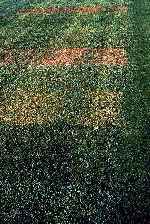| |
Rust | |
| |
|
|
| |
|
|
| |


 | Puccinia poae-nemoralis
Disease description
Puccinia poae-nemoralis - brown fleck rust of Kentucky blue grass, also found on other turf grasses
P. recondita - brown or leaf rust on several turf grass species.
P. graminis - black or stem rust on several turf grass species.
Rusts develop late in most seasons and so are seldom severe on mown turf grass; P.
poae-nemoralis is sometimes an exception. Several rust species may seriously damage grass seed crops.
Predisposing factors
- low fertility, especially in nitrogen towards the end of the growing season
- inadequate irrigation
- susceptible cultivars as mentioned
Cultural control
Where P. poae-nemoralis is a problem avoid the 'Merion' cultivar of Kentucky blue grass. Maintain vigorous grass growth in summer.
|
|
|
| |
|
|
| |
For more information about the content of this document, contact Shelley Barkley.
This information published to the web on June 1, 2001.
Last Reviewed/Revised on June 1, 2018.
|
|